I am writing this introduction in January 2022, on a sweltering day after enjoying a swim and time in the park. It is great to be out and about with people again, enjoying everything our city has to offer. There is a sense of relief among all Aucklanders, having gone through some tough times during the Covid-enforced lockdown. My thanks go out to everyone who played their part, especially the frontline staff who kept the city running. Having Covid return has placed a spanner in many of the works we had planned this year, but I am proud of what we have managed to achieve and hope you enjoy reading my report summarising the year’s work.

Dawn on Puketāpapa
This year, I was honoured to be supported by the board to step into the Deputy Chairperson role, following Harry Doig’s decision to step down from the position. Harry has done an excellent job as both Chair and Deputy Chair over the past four years, and it has been great to have his support over the last 8 months. I had the misfortune of having to accept the nomination while at home on the computer due to a bad bike accident going down Hendry Avenue. Little did I know at the time that I would be spending a lot more time on Skype in the second half of the year!

Puketāpapa Local Board Member Bobby Shen and Councillor Cathy Casey join a zoom
My role as the Deputy has been very interesting and a big step up in time and effort. There is an additional full day of meetings, which see Chair Julie Fairey and I meeting with staff, nutting out issues prior to the workshops, and getting updates on a range of problems occurring across the Council. We also meet with representatives from Community Facilities, Auckland Transport, Connected Communities, Communications, and other arms of Council to ensure things are progressing well. Every week has meetings on other days held with constituents, staff, other local boards or the Governing Body. The latter meetings have been a great insight into the running of Council and the issues faced across the city, with the development of the 2022 Annual Budget the most recent example.
I also stepped up as we went into lockdown to awhi/support Julie over that difficult period. Over the course of lockdown, I chaired workshops and business meetings, triaged emails and represented the board at a range of different meetings.
This year I have organised my report into the six outcome areas outlined in our Local Board Plan. One of the benefits of doing this for me was seeing how the work we do often fits into multiple outcomes. First of all though, a brief update on my role as chair of the Manukau Harbour Forum.
Highlights of the year for the Forum included:
- attending the Young Leaders Sustainability Wānanga at Ambury Farm
- hearing from students who are involved in environmental projects to protect and improve the harbour
- a field trip on the Manukau Harbour aboard the boat Ratahi, where we toured the Waiuku River, Waiuku Channel, Awhitu Peninsula and across to Cornwallis
- a visit to Ngāti Tamaoho’s offices where Ted Ngataki shared with us his vision for restoring the Pahurehure inlet
- hearing from Makaurau marae about the excellent mahi they have done in Oruarangi and the harbour
- welcoming our new coordinator Julie Chambers
- the release of the State of the Harbour report in June. This report confirms the state of degradation in the harbour, but reported some positive trends. We will use this in our advocacy for increased spending on restoring the harbour, with the long term goal of a restoration plan developed with mana whenua, scientists, community members and council organisations.

Cornwallis Wharf
Sadly this year, there have been several deaths in the harbour, and our end-of-year report included advice from Water Safety NZ on keeping safe in the harbour. One of the forum’s goals is to highlight the recreational values of the harbour, but an essential part of that is respecting the at-times dangerous nature of the Moana.
Over the next year we will be looking at how we can better work with mana whenua around the harbour, communicating with the public, running the youth wānanga and continuing to advocate for the harbour at Governing Body and externally.
Outcome 1: Inclusive communities that are healthy, connected and thriving
This year has been a tough one for the community groups we work with, who have seen long-planned events cancelled or shifted online while doing their best to support members of the community and keep us thriving. Their work includes running foodbanks, delivering shopping, translating, helping people access services to survive, running vaccination events, creating content for people to enjoy and much more. Thank you to all these groups for the hard work you do for the people of Puketāpapa and beyond. This year we funded a range of community groups – including Urdu Hindi, Scottish Celtic Music, Roskill Chinese Group, Environmental Groups, Number 3 Roskill Theatre Trust, Bhartiya Samaj and many more through our grant programmes. All of the groups we work with – whether through funding or just support – do great work to bring our community together.

A Puketāpapa Community Network meeting
The Puketāpapa community network really took off in 2021 thanks to the hard work of Zena Wrigley. It was great getting together with representatives of groups working in Puketāpapa and sharing information and korero. One of the highlight events for me was the event at Auckland United Football Club co-hosted with Auckland Emergency Management. I hadn’t really thought about the role our institutions can play in an emergency, and look forward to the further development of an emergency plan for Puketāpapa. Sadly, the lockdown meant the network has been unable to meet since August.
We managed to get some events in this year, with highlights being the kite day on Puketāpapa as part of Matariki, a night market at Wesley and the World of Cultures festival. The latter half of the year saw us having to cancel some events, and we remain hopeful that in 2022 we can return to hosting events safely for all.

Waikōwhai Intermediate principal David King was one of the first to try out the flying fox!
This outcome also looks at our community facilities, and it was great to be able to ‘reopen’ the new Keith Hay Park playground. Waikōwhai Intermediate provided beautiful waiata, and Papa Fred Holloway blessed the completed works and sang us a waiata of his own. This project was long overdue and was the only slice of capital expenditure we had to spend in the 2020 work programme.
Staying within Keith Hay Park, it was a privilege to be invited to the opening of the Auckland United clubrooms. With support from Auckland Council, a massive community fundraising effort means we now have potentially the best clubrooms in Auckland in our area. It was great getting down there and watching the men’s and women’s teams play until the season was cut short due to the lockdown.

A full crowd down at the clubrooms
Works also continued on repairs and upgrades to the Lynfield Community Centre, Cameron Pools, the track to Wesley Bay and other miscellaneous items. Sadly the track in Belfast Reserve has not been reopened, despite us asking for it to be prioritised. It is an expensive and challenging piece of work, and we will be getting an update on it in the new year. Reopening the top track will mean Goodall and Belfast street are reconnected and that members of the public will be able to access the beautiful bush in the reserve.
Outcome 2: Our people speak up and help shape our future
One of the absolute highlights in this outcome was the continued development of the Integrated area plan the board is developing in partnership with Albert-Eden Local Board and mana whenua representatives. This plan will guide the development of a well-defined area that will see massive development over the next 30 years. We have done an initial public engagement on the draft, worked with CCO’s like AT and Watercare, Kāinga Ora and Transpower, and have developed it over the year in monthly sessions where we share the table with mana whenua representatives. Usually, council documents are presented as a nearly complete document to mana whenua to give feedback on, instead, this process has allowed the development of the plan the whole way through. We have had lots of great korero and built some excellent relationships throughout the process.
We have also continued working with our partnership groups Roskill Chinese Group, Somalian Education and Development Trust, Global Hope Missions and the Puketāpapa Youth foundation to ensure council consultations reach a wider audience than the usual respondents, and this is reflected in the demographics of submissions from our board area. Unfortunately, lockdown in the second half of the year made this a lot more complicated.
The board also submits on behalf of our constituents on central government submissions such as Three Waters, the Emissions Reduction Plan, the National Policy Statement on Urban Development and many more. It has been a year full of rapid turnarounds for this – often, we will have a week to put our feedback together in time to have it included in the Council’s submission. Many thanks to the staff on the local board who have helped us put these together.
We also feedback on Council policy documents, such as the Age-Friendly City work, Freedom Camping Bylaw, advertising bylaw and many more. One really disappointing outcome in this space was the sale of AIMS, the council owned company that worked in our community facilities. I am a firm believer that core services like this shouldn’t be contracted out, and all of the local boards affected submitted against the proposal. We can only hope that the new company is committed to paying the living wage for staff and providing a good outcome for residents rather than focusing on their bottom line.
Outcome 3: Our environment is protected and enhanced for present and future generations
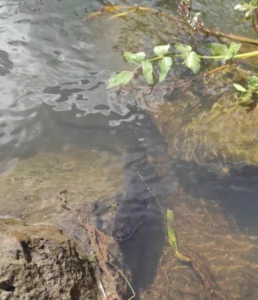
Eel in Te Auaunga-Oakley Creek
This outcome is one I always have front of mind, and one I am constantly trying to address through our work programme, grants, business as usual programmes and submissions to the governing body and central government. Within our rohe, we signed off on the Urban Ngahere plan, which analyses the tree cover of Puketāpapa, analyses gaps, and provides guidance on where we should focus funding for street and park trees. Our forest cover is relatively high compared to many other boards, sitting at 20 percent. However, this is skewed by the Waikowhai Coast and Monte Cecilia, and we have some areas with extremely low tree cover, particularly Wesley. Street trees provide many benefits, including carbon capture and improving amenity. Sadly, there is usually a direct link between areas of high deprivation and lack of street trees. I look forward to this programme getting trees into the ground next planting season.
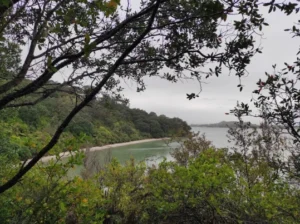
Waikōwhai Park
Although the current hot weather is great for swimming, the news that 2021 was the hottest year on record for Aotearoa is a reminder of the reality of Climate Change. Helping communities adapt to climate change, and trying to reduce our carbon emissions, is a focus of our board. We have funded a Climate Activator who works with community groups and businesses to reduce carbon, as well as assessing what we can be doing better as a board. Our work in transport, intensification, street trees, community gardens and planning all aims to reduce emissions, increase walkability and ensure our community can thrive in the face of ever-increasing temperatures. It can be demoralising in our role seeing decisions get made that lock in carbon emissions but it is important we focus on the good things we can do.
One noticeable effect of lockdown has been the increased prevalence of weeds in areas usually looked after by volunteers. Volunteer groups haven’t been able to get out to tend to new plantings as well, so lots of work to be done this summer! Friends of Wairaki Stream managed to get a couple of working days in at the end of the year, mostly releasing the plantings from last year, which were being enveloped by Kikuyu.
The board also funded ecological restoration in Lynfield Reserve and Ramelton Reserve, which involved removing a lot of pest plants and rubbish. Ramelton Reserve was also the site of some great work by our Migrant Volunteer Coordinator, who worked with Conservation Volunteers to get migrants with English as a second language into the environment. Ramelton Reserve really is a ‘hidden gem’ – I’d say most people who live on the street don’t even know it’s there. It is home to a small section of the very rare (in Tāmaki Makaurau) rock forest, a small stream, and some lovely native plants. Hopefully, this work will pick up again in 2022.
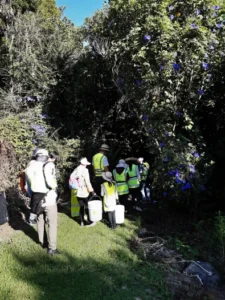
Volunteers heading into Ramelton Reserve – check out the Blue Morning Glory
We also fund the eco neighborhoods programme, which gives a small amount of funding to community groups who are doing ecological projects. This year, the star of this programme is the food forest in Molley Green Reserve, known as Tā Tātou Māra Kai. Local resident Rowan Cant has done lots of hard work to get this in place, with the land lease being held by Whenua Warrior, who did an excellent job on the initial setup. This garden will provide food security, reduce waste through composting and build community as the area is redeveloped by Kāinga Ora.

The first working day in Molley Green Reserve.
One area I would like to see a greater focus on is improving the water quality of our awa/rivers, something that mana whenua have constantly highlighted as important in our development of the integrated area plan. Our two main awa are Te Auaunga/Oakley Creek and Wairaki Stream. Te Auaunga runs from Molley Green Reserve all the way to the Waitematā Harbour and ends up being one of the most polluted waterways in Tāmaki Makaurau. I have pushed for increased monitoring along the stream, especially at our end, so we can begin to identify where the pollution enters the creek. Healthy Waters have started an investigation into wastewater overflows into Wairaki Stream, which then end up polluting Lynfield Cove. This is a labour-intensive job, but an important one. It will require the council working with private landowners to clean up any connections that enter the stream.
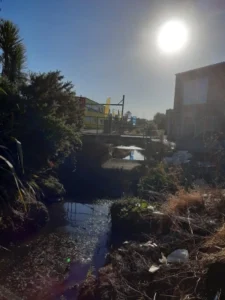
Rubbish in Te Auaunga
Outcome 4: Well-planned neighbourhoods
A big part of our work in this area has been the Integrated Area Plan mentioned in Outcome 2. We have worked hard to develop a document that developers, council and central government can use to refer to over the next 30 years. This document will be going out for engagement in early 2022. Some of the significant outcomes I championed were the restoration of waterways, an emphasis on low carbon, increased recognition of heritage in the area and improved active transport networks and links to build on the existing greenway network.
The board also signed off on concept plans for Hillsborough Cemetery and Margaret Griffen Park, as well as a needs assessment for the Three Kings area and an analysis of the playgrounds in the area, which makes recommendations as to future improvements. I have been trying to get these added to the website for ease of downloading, but in the meantime am happy to share with interested members of the public.
A big part of the board’s role in this space has been advocacy to Kāinga Ora. We have regular meetings where we are updated on the works which are coming, the scale of which will be huge for our board. Kāinga Ora have developed an Urban Ngahere strategy which includes an analysis of all the trees that are in Waikowhai, identifying which ones can be kept and which will be removed, and what will replace them. This sprung from their experience in Roskill South, where a lot of the longstanding trees in the neighborhood were removed. They have now covenanted two Puriri trees in Roskill South, meaning these will stand for a long time and provide shelter to the new residents in the area.
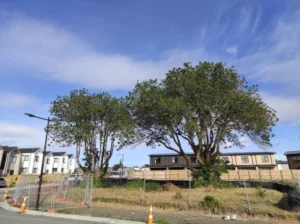
Two protected puriri trees
We all recognise the importance of intensification and providing more houses for people, and Mt Roskill is well placed for this. However, the growing pains of intensification can be really tough, especially for residents who end up surrounded by construction works. We have had year-long road closures, bus disruptions, and noise complaints, and have worked with Watercare, Kāinga Ora, and Piritahi to get these remediated where we can. The next stage for Kāinga Ora will be the Waikowhai neighbourhood – a massive operation that will see the neighbourhood massively changed. It is vital we continue to have the voices of current residents heard while planning for the future.
An essential part of doing intensification right is providing green spaces of different sizes that are walkable for the residents. Freeland Reserve is coming along quickly, the new park on the corner of Burnett and Howell is awaiting signoff from Council internally, and there are proposals for better public spaces around McKinnon Street in Waikowhai. There will be a fair bit of consultation around the future of Molley Green Reserve this year, a park that is really important as it sits very close to the headwaters of Te Auaunga/Oakley Creek.
Outcome 5: Transport options that are reliable, accessible and less polluting
There has been quite a lot of action in the transport space in 2021, a welcome change from last year when many projects were put on hold. Early in the year, I presented to representatives of Waka Kotahi and Auckland Transport as part of the Regional Land Transport Plan. We highlighted that the plan saw emissions rising by 6% and questioned the validity of this in a climate emergency, a view echoed by a number of groups. We advocated for rapid transit down Dominion Road, an investigation into the Southdown-Avondale rail connection, a significant increase into active transport funding with a focus on the cycle network prioritised by Auckland Transport’s future connect, for urgent work on the Hendry Ave/Queenstown Road cycle network and an increase in the footpath repair budget. Not all of these requests were successful, but it was great to see an extra $20 million for new footpaths.
We were unable to get the Queenstown road project reinstated into the RLTP after it disappeared from the previous iteration, but after an OIA request from me about this, we were surprised by a raised pseudo-crossing on Queenstown Road by Waka Kotahi. The plan is that this will be gazetted as a crossing following data collection by AT. This should make this crossing, on a crucial part of Auckland’s cycle network, a lot safer.
There have been a number of small projects completed in our area: the Arundel street roundabout, broken yellow lines on Hillsborough Road, the first stage of a safer Greenway network through from Mt Roskill Grammar to Monte Cecilia Park, safety works outside Wesley Primary, some of the May Road pedestrian improvement works, and wayfinding signage for cyclists painted on the footpath. The last project was one I managed to get for the Local Board thanks to a tipoff about funding available from Waka Kotahi. Ideally we will get some physical signage in the future, but I have had a few positive comments about these already.
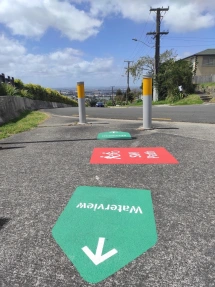
Freshly installed
A lot of planning and consultation took place this year, most notably for the Mt Roskill Safer Routes part 2, which will see Dornwell Road made a one-way entry, additional pedestrian crossings and safer facilities for cycling. This intersection is a high-risk one with several serious crashes in recent years and a vital link to the schools. The main theme in the consultation feedback was “where is the cycling infrastructure?” and Auckland Transport has taken this on board and is coming back with an improved plan. The climate action plan, Te Tāruke-ā-Tāwhiri sets a goal of having 7% of trips taken by cycling, and to do that we need to be building that infrastructure into every project.
One potentially massive project that was consulted on this year is the rapid transit route from the city centre to the airport. The project will be huge for our area, with either of the proposed routes running through Puketāpapa and alongside SH20. Many people in Mt Roskill commute to the airport precinct and into the central city, so our board has supported bringing light rail back for a long time. Julie stepped aside from any discussions on the project to avoid any perceived conflict of interest and I represented the board at the local board meetings looking at the project. We supported an at-grade (street level) project as it provides lots of opportunities to improve neighbourhoods, costs less, and serves more people. We also supported ensuring businesses were compensated during works, improved active transport connections, and ended up favouring a Sandringham Road route to connect through to the intensification coming in Wesley. We wait to see what the decision made by cabinet will be.
Next year we should also see the roundabout built at the Hillsborough Road/Commodore drive intersection, new pedestrian crossings on Hayr Road, Hillsborough Road near Goodall and by Waikōwhai Primary, Denbigh Avenue, Stoddard Road, and Pah Road. Making it easier for people to get around by foot is a crucial part of making this a great city to live in, and these small projects will make a big difference. We have also been briefed on the plans for fixing/upgrading footpaths, and I look forward to these taking place – particularly on Hillsborough and Dominion Road, both of which are well past their use-by date.
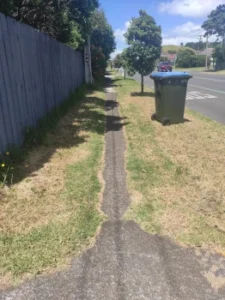
A footpath beside Dominion road, our main arterial road
I worked with our strategic broker and Richard from PATH to put together our application for the Regional Streets for People programme. If our application is successful, we will get $300,000 for the local board to run an intensive program working with schools to put on bike trains, run events, and look at infrast
ructure challenges over a three year period. Our safe cycle network links up 10 different schools, and increasing the number of students cycling, scootering and walking will be a great outcome for health, the environment, and traffic congestion. We find out early in 2022 whether or not we will be successful.
Outcome 6: Thriving local economy with opportunities to learn, work and volunteer
This outcome has come to the fore during the latest Covid lockdown. Auckland Council has provided some great programmes for local businesses, and our board has funded small business programmes such as a mentor programme, social enterprise development, youth employment schemes and are working with a fledgling business group.
Auckland Council put out a report in 2020 looking at the effects of Covid, and one of the recommendations was an increase in environmental volunteer groups. The report found a return of $3.14 for every dollar spent on these volunteer groups. Our board puts aside $30,000 directly for environmental volunteers, as well as the eco neighborhood work mentioned in Outcome 5. This allows for tree planting, pest control, stream cleaning, rubbish removal and care for our environment, all while bringing people of all types together.
Volunteers were behind the well-run and very successful vaccination days at Wesley Community Centre. Multiple groups collaborated to help raise the number of vaccinated people in Wesley, which was one of the lowest vaccinated regions in Central Auckland. Both days were lots of fun and everything went smoothly.

The cool carpark team on the second day of the vaccine drive
We fund many community groups through our grants schemes, as well as through targeted programmes, and most of these are run through volunteer labour. These are the groups that hold our community together in tough times, and it is great to be able to make this a focus of our work. It was disappointing our Volunteer awards weren’t able to be held in person this year, but it was great to be able to ring some of the recipients and talk about their mahi. Congratulations and thank you to Peter Leilua, Yinling Tsang, Kathy Neilson, Dianne McCarthy, Canute D’Souza, Lionel and Aoto’a Teleaga, Michael Howell, Issy Lim, Doreen Wakefield and Malcolm Rundle.
We continue to contribute extra funds to our Mt Roskill library out of our discretionary funding, and they do an awesome job helping out our community. They were one of the first libraries open back after the lockdown, and they were swamped with requests! They also run lots of events, hold language classes, provide internet access, and help people out with all manner of issues– all with a great attitude.
2022 marks the final year of my first term on the board. It has certainly been interesting! I have continued working as a teacher, started my masters in Public Policy and volunteer at Owairaka parkrun and Friends of Wairaki Stream. It is an honour to represent the people of Puketāpapa in my work and I look forward to continuing to do so this year. My thanks again to the staff who put in many hours of work to help us do our jobs and to keep working to make Puketāpapa a great place to live. Please feel free to contact me any time, either via email at [email protected], on my facebook page http://www.facebook.com/jt4plb or give me a call on 0211903734.

